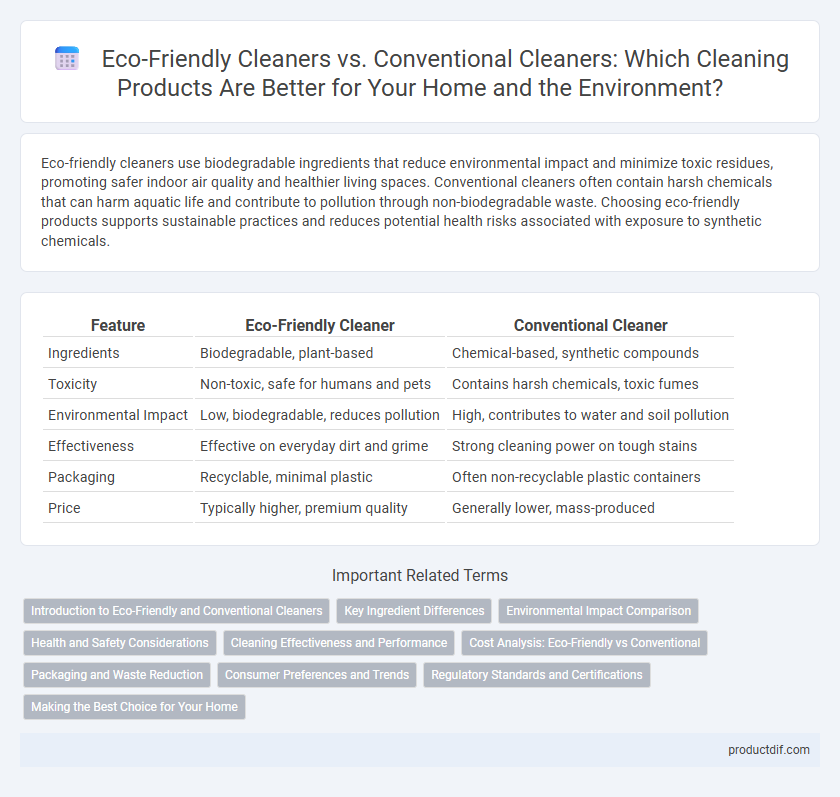Eco-friendly cleaners use biodegradable ingredients that reduce environmental impact and minimize toxic residues, promoting safer indoor air quality and healthier living spaces. Conventional cleaners often contain harsh chemicals that can harm aquatic life and contribute to pollution through non-biodegradable waste. Choosing eco-friendly products supports sustainable practices and reduces potential health risks associated with exposure to synthetic chemicals.
Table of Comparison
| Feature | Eco-Friendly Cleaner | Conventional Cleaner |
|---|---|---|
| Ingredients | Biodegradable, plant-based | Chemical-based, synthetic compounds |
| Toxicity | Non-toxic, safe for humans and pets | Contains harsh chemicals, toxic fumes |
| Environmental Impact | Low, biodegradable, reduces pollution | High, contributes to water and soil pollution |
| Effectiveness | Effective on everyday dirt and grime | Strong cleaning power on tough stains |
| Packaging | Recyclable, minimal plastic | Often non-recyclable plastic containers |
| Price | Typically higher, premium quality | Generally lower, mass-produced |
Introduction to Eco-Friendly and Conventional Cleaners
Eco-friendly cleaners use biodegradable ingredients that minimize environmental impact and reduce exposure to harmful chemicals, making them safe for households and waterways. Conventional cleaners often contain synthetic chemicals such as ammonia and chlorine, which can cause respiratory issues and contribute to pollution. Choosing eco-friendly products supports sustainability by promoting natural formulas that break down easily and avoid toxic residues.
Key Ingredient Differences
Eco-friendly cleaners use natural ingredients like plant-based surfactants, essential oils, and biodegradable solvents that break down quickly without harming ecosystems. Conventional cleaners often contain synthetic chemicals such as ammonia, phosphates, and chlorine, which can be toxic and persist in the environment. The key difference lies in the ingredient source and environmental impact, with eco-friendly products prioritizing sustainability and safety.
Environmental Impact Comparison
Eco-friendly cleaners are formulated with biodegradable ingredients that minimize pollution and reduce harm to aquatic ecosystems, unlike conventional cleaners containing synthetic chemicals and phosphates that contribute to water contamination and toxicity. Studies show that eco-friendly products often have a lower carbon footprint throughout their lifecycle, from production to disposal, enhancing sustainability efforts. Switching to green cleaning solutions supports environmental preservation by decreasing hazardous waste and promoting safer air and water quality.
Health and Safety Considerations
Eco-friendly cleaners typically contain non-toxic, biodegradable ingredients that reduce chemical exposure and lower risks of respiratory issues or skin irritation compared to conventional cleaners. Conventional cleaners often include harsh chemicals such as ammonia, chlorine, and synthetic fragrances, which can cause allergic reactions, endocrine disruption, and indoor air pollution. Choosing eco-friendly cleaning products enhances indoor air quality and promotes a safer environment for children, pets, and individuals with sensitivities.
Cleaning Effectiveness and Performance
Eco-friendly cleaners use biodegradable ingredients that effectively remove dirt and grime while minimizing environmental impact, often matching the cleaning power of conventional cleaners. Conventional cleaners typically contain strong chemicals that provide quick and thorough stain removal but may leave harmful residues and contribute to indoor air pollution. Advances in green chemistry have enhanced the performance of eco-friendly products, ensuring effective sanitation without compromising safety or efficacy.
Cost Analysis: Eco-Friendly vs Conventional
Eco-friendly cleaners often have a higher upfront cost compared to conventional cleaners due to natural ingredients and sustainable packaging. Over time, eco-friendly products can offer cost savings by reducing the need for multiple specialized cleaners and minimizing health-related expenses. Conventional cleaners typically have lower initial prices but may lead to higher environmental and health costs in the long term.
Packaging and Waste Reduction
Eco-friendly cleaners use sustainable packaging materials such as recycled plastics, biodegradable films, and refillable containers that significantly reduce environmental impact. Conventional cleaners often rely on single-use, non-recyclable packaging that contributes to landfill waste and pollution. By choosing eco-friendly packaging, consumers support waste reduction initiatives and promote circular economy practices in the cleaning product industry.
Consumer Preferences and Trends
Consumers increasingly prefer eco-friendly cleaners due to growing awareness of environmental impact and health benefits, driving market demand toward biodegradable and non-toxic ingredients. Conventional cleaners, often featuring stronger chemicals like ammonia and bleach, face declining popularity amid concerns about toxicity and indoor air quality. Trends indicate a surge in products labeled as sustainable, cruelty-free, and safe for sensitive skin, reflecting a shift in purchasing behavior toward greener cleaning solutions.
Regulatory Standards and Certifications
Eco-friendly cleaners comply with stringent regulatory standards such as the EPA's Safer Choice program and certifications like Green Seal, ensuring reduced environmental impact and safer ingredients. Conventional cleaners often rely on less rigorous regulations, potentially containing harsher chemicals that can pose risks to health and the environment. Certifications for eco-friendly products provide consumers with reliable indicators of safety and sustainability, driving informed purchasing decisions.
Making the Best Choice for Your Home
Eco-friendly cleaners use biodegradable ingredients and avoid harmful chemicals, reducing indoor pollution and environmental impact while safeguarding your family's health. Conventional cleaners often contain strong synthetic chemicals that can cause respiratory irritation and persist in waterways, posing long-term ecological risks. Choosing eco-friendly products ensures effective cleaning with plant-based formulas that break down naturally, promoting a safer, healthier home environment.
Eco-Friendly Cleaner vs Conventional Cleaner Infographic

 productdif.com
productdif.com